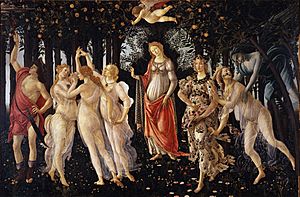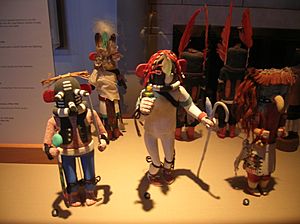Aby Warburg facts for kids
Quick facts for kids
Aby Warburg
|
|
|---|---|

Aby Warburg around 1925
|
|
| Born |
Aby Moritz Warburg
June 13, 1866 |
| Died | October 26, 1929 (aged 63) Hamburg
|
| Nationality | German |
| Occupation | Art historian |
| Spouse(s) |
Mary Hertz
(m. 1897) |
| Children | Marietta (1899–1973) Max Adolph (1902–1974) Frede C. Warburg (1904–2004) |
Aby Moritz Warburg, known as Aby Warburg, was a German art historian and cultural theorist. He was born on June 13, 1866, and passed away on October 26, 1929. He created a special private library called the Kulturwissenschaftliche Bibliothek Warburg. This library later became the famous Warburg Institute in London.
Aby Warburg's main interest was how ideas and images from the ancient world, especially from Ancient Greece and Ancient Rome, continued to influence Western culture, right up to the Renaissance. He once described himself as: "Amburghese di cuore, ebreo di sangue, d'anima Fiorentino" (meaning 'Hamburger at heart, Jewish by blood, Florentine in spirit').
Contents
Life of Aby Warburg
Aby Warburg was born in Hamburg, Germany. His family, the Warburg family, were wealthy German Jewish bankers. His ancestors had moved to Germany from Italy in the 1600s. They settled in a town called Warburg and took its name as their family name. Later, in the 1700s, they moved closer to Hamburg.
Two Warburg brothers started a banking company called M. M. Warburg & Co in Hamburg. Aby was the first of seven children. His father, Moritz Warburg, was a director at the bank. Aby was interested in books and history from a young age. His younger brothers, Max Warburg, Paul Warburg, and Felix Warburg, all became bankers. Max Warburg helped make the family bank famous around the world.
Early Life and Education
Aby grew up in a traditional Jewish home. He was a lively and sometimes unpredictable child. He didn't like the strict religious rules his family followed. He also didn't want to become a rabbi, doctor, or lawyer, which his family hoped for.
Aby Warburg really wanted to study art history. His family wasn't happy about this at first. But Aby made a famous deal with his brother Max. As the oldest son, Aby had the right to take over the family bank. He gave up this right to Max. In return, Max promised to buy Aby all the books he would ever need for his studies.
In 1886, Warburg began studying art history, history, and archaeology. He studied in different cities like Bonn, Munich, and Strasbourg. He wrote his main paper about two famous paintings by Sandro Botticelli: The Birth of Venus and Primavera.
From 1888 to 1889, he went to Florence, Italy, to study these paintings more deeply. He wanted to use scientific methods to understand human culture. He finished his paper in 1892. Warburg's work introduced a new way of studying art called iconography. This method looks at the meaning of symbols and images in art. After getting his degree, Warburg even studied psychology for a short time in Berlin.
Travels in America
In 1895, Aby's brother Paul got married in New York City. This was the start of Aby Warburg's travels in the southwestern United States. Before going West, he met important anthropologists, who study human cultures, at the Smithsonian Institution.
Warburg visited Mesa Verde to see ancient cliff dwellings. He also visited many Pueblo villages in New Mexico. He took photos of a traditional Antelope dance. In one village, he asked a priest and his son to draw their beliefs about the world. Their drawing showed how important weather and snakes were to their culture.
Warburg was very interested in the snake dance of the Hopi people in Arizona. He learned about it from others, and even though he never saw it himself, it greatly influenced his ideas. He was fascinated by Hopi culture, including their buildings, ceremonies, masks, and pottery. A missionary named Henry Voth helped Warburg learn more about Hopi religion and allowed him to see some sacred ceremonies. Warburg also attended Kachina dances.
Warburg's American travels inspired him to take photos and study different cultures. He later used his notes from these trips for a famous lecture in 1923. In this lecture, he talked about how religious thinking in ancient Athens was similar to that of the Hopi in Oraibi. This lecture was also important because it helped him leave a mental health clinic.
Life in Florence
In 1897, Warburg married Mary Hertz, a painter and sculptor. They moved to Florence, Italy, in 1898. They had three children: Marietta, Max Adolph, and Frede. Even though Warburg sometimes struggled with his mental health, they had an active social life in Florence. They met many artists, writers, and historians.

In Florence, Warburg studied the lives of Renaissance artists and their wealthy supporters. He also looked at the economy of Florence during the early Renaissance. He gave lectures about Leonardo da Vinci, discussing how Leonardo studied old books about animals and human body proportions. He also looked at how Botticelli showed ancient ideas in the clothing of his figures.
Warburg wrote a famous essay about the clothing of women in a fresco by Domenico Ghirlandaio in Florence. He noticed the difference between the tight dresses of older women and the light, flowing clothes of a younger, fast-moving figure. This showed how people around 1900 were discussing freedom in women's fashion.
Return to Hamburg and Later Life
In 1902, Warburg and his family moved back to Hamburg. He shared his research findings in lectures but didn't take a full-time teaching job at first. He helped start the "Hamburger wissenschatflichen Stiftung" (a scientific foundation) and supported the creation of a university in Hamburg, which opened in 1919. He later became a professor there.
Around this time, Warburg faced significant health challenges. He struggled with his mental health and was hospitalized in Switzerland in 1921. After getting support and treatment, his condition improved. He was able to leave the clinic in 1924. From 1925 to 1929, he gave occasional lectures and seminars, often in his private library.
Aby Warburg passed away in Hamburg on October 26, 1929, from a heart attack.
The Mnemosyne Atlas
In 1927, Warburg began his last big project, a picture atlas called Mnemosyne. It was made of 40 wooden panels covered in black cloth. On these panels, he pinned almost 1,000 pictures. These pictures came from books, magazines, newspapers, and everyday life. He arranged them into different themes, like:
- Memory and ideas
- Astrology and old stories
- Ancient models
- How old gods traveled through time
- Ways ideas are passed down
- When ancient ideas appeared again
- Dionysian feelings (strong emotions)
- Nike (victory) and Fortuna (luck)
- From the Muses (goddesses of arts) to modern art
- Dürer (a famous artist) and the gods moving North
- The age of Neptune (god of the sea)
- Official art and the Baroque style
- Ancient ideas coming back
- The classical tradition today
The atlas had very few words. Warburg hoped that people looking at it would feel the same strong emotions he did when he chose the images. The Mnemosyne Atlas was not finished when he died in 1929.
Warburg's Importance in History
Aby Warburg is seen as a very important figure in the humanities, which are studies about human culture, during the early 1900s. Even though he was respected by other scholars, he wasn't widely known. His work was almost forgotten during Nazi Germany and after World War II. This was partly because only a few of his writings were published. Many of his ideas were in his notes, letters, and unfinished papers.
His library and staff moved to London in 1933, becoming the Warburg Institute. This helped introduce the study of art history to the English-speaking world.
Interest in Warburg grew again after a biography about him was published in 1970. Since the 1970s, many of his writings have been published. This has allowed more people to understand his ideas. Warburg introduced Iconology as a way to study art. This method looks at the deeper meaning of images, not just their appearance. Many of the words and phrases he created are still used in art history today.
For example, his famous quote "God is in the details" means that you need to study many different documents and small things to truly understand a piece of art and its history. This way of working is often linked to the "Warburg School" of thought.
Warburg and his library greatly influenced the study of the Italian and German Renaissance. He made people pay more attention to how ancient ideas, pagan beliefs, and magical image practices continued to influence European history, especially during the Renaissance. His work is still important today, especially for those who study how images affect our culture.
See also
 In Spanish: Aby Warburg para niños
In Spanish: Aby Warburg para niños
- Aby Warburg Prize
- Jean Seznec
- Pathosformel
- Warburg Haus, Hamburg
- Warburg Institute






